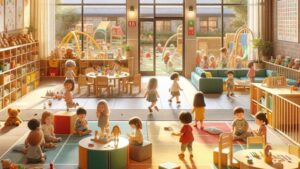
Daycare Advice for Parents: How to Choose a Safe Daycare
Get essential daycare advice for parents on choosing a safe daycare. Learn safety tips, regulations, and how to ensure a secure environment for your child.
A well-designed daycare indoor space is crucial for the success of any daycare business. The layout, organization, and functionality of indoor spaces impact children’s safety, learning experiences, and overall enjoyment. Thoughtfully designed areas for play, learning, meals, and rest ensure a balanced and nurturing environment that meets the needs of both children and staff.

Safety and organization are the foundations of any effective daycare indoor space. Ensuring that your environment is both secure and functional helps create a smooth daily routine. Important safety and organization features include:
According to childcare safety guidelines, having a clutter-free environment reduces the risk of accidents and helps children focus on activities. Designated areas for different activities—such as reading, art, and dramatic play—help children understand expectations and routines.
Regular safety checks and maintenance ensure that your daycare business remains compliant with regulations, providing peace of mind to both parents and staff.
Dividing your daycare indoor space into specific learning zones promotes educational growth and keeps children engaged. Key learning zones to consider include:
Research shows that structured learning environments help children develop cognitive and social skills. For example, a reading zone supports early literacy, while an art station encourages fine motor development and self-expression.
Rotating the materials in each zone keeps activities fresh and exciting. By incorporating varied learning zones, your daycare business can cater to different interests and learning styles, enhancing overall child development.
Play is essential for physical, social, and emotional development. Design your daycare indoor space to include areas that encourage movement and interaction. Important play areas include:
According to the American Academy of Pediatrics, play helps children develop important life skills, such as cooperation and communication. Indoor play areas provide opportunities for children to engage in physical activity, even when outdoor play is not possible.
Ensuring that play areas are supervised and age-appropriate keeps children safe while allowing them to explore and build friendships. These spaces make your daycare business a fun and dynamic place for children.
Rest is vital for young children’s growth and well-being. Creating a comfortable and safe nap area in your daycare indoor space helps children recharge and stay happy throughout the day. Essential nap area features include:
The National Sleep Foundation recommends 1-2 hours of daytime sleep for preschool-aged children. A consistent nap routine supports physical health and emotional regulation.
By providing a peaceful and comfortable nap area, your daycare business helps children stay refreshed and ready for the rest of their day. Parents also appreciate knowing that their children are getting the rest they need.
Thoughtfully designing your daycare indoor space ensures a safe, engaging, and educational environment. By focusing on safety, learning zones, play areas, and nap spaces, you create a balanced setting where children can thrive. A well-planned indoor space enhances your daycare business’s reputation and provides a nurturing atmosphere that parents trust and children love.

Get essential daycare advice for parents on choosing a safe daycare. Learn safety tips, regulations, and how to ensure a secure environment for your child.

Ensure you’re selecting the best daycare with our comprehensive parent checklist. Get crucial daycare advice for parents to make an informed and confident choice.

Practical daycare advice for parents on preparing their autistic child for a successful and comfortable transition into daycare.

Get essential daycare advice for parents on deciding between a nanny and daycare. Understand the pros, cons, and key factors to make the best choice for your child.

Get essential daycare advice for parents on choosing a safe daycare. Learn safety tips, regulations, and how to ensure a secure environment for your child.

Ensure you’re selecting the best daycare with our comprehensive parent checklist. Get crucial daycare advice for parents to make an informed and confident choice.